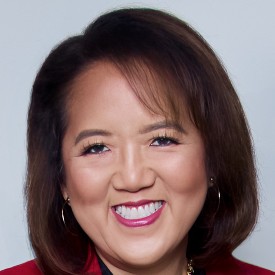As the former CEO of AT&T Business, Anne Chow led a $35B business comprised of more than 35,000 employees who collectively served 3 million business customers worldwide. Known for her inspirational ability to create and grow high performing teams, she was also the first woman of color to hold the position of CEO at AT&T. She is currently the Lead Director on the board of Franklin Covey, serves on the boards of 3M and CSX, and teaches at Northwestern University’s Kellogg School of Management.
What’s the big idea?
Inclusive leadership has been pigeonholed into boilerplate DEI initiatives. The world requires significantly more complex growth, innovation, and personalization than these narrow concepts of inclusion. What the world needs is bigger leaders that lead big. This is what Anne Chow, former CEO of AT&T Business, has concluded after over three decades of leadership experience as the first woman of color to hold that title in company history. Chow emphasizes the power of a humanistic approach to strengthen companies as they are rocked by seismic technological shifts. Through her suggested practices and mindsets, leaders can advance work that matters, engage a dynamic workforce, and foster an agile workplace.
Below, Anne shares five key insights from her new book, Lead Bigger: The Transformative Power of Inclusion. Listen to the audio version—read by Anne herself—in the Next Big Idea App.

1. Go beyond the daily grind.
Bigger leaders must do the work to develop, harness, and evolve purpose as the foundation and reason for being. Without purpose, work risks becoming meaningless or irrelevant, stakeholders will be uninspired, loyalty will be scarce, and a purpose-led team will outcompete you.
Some people might think that unless you’re the founder of a company, an entrepreneur, or CEO, the purpose of your work is for someone else to decide. This couldn’t be further from the truth. Our purpose is the essential why behind the work we do. It is different than an organization’s mission, which represents an objective and set of actions that an individual or set of people are charged with.
No matter the kind of work you do, you are on a mission to reach a destination that yields desired outcomes for stakeholders. If you are not sure what your purpose is, ask yourself, what if we didn’t exist? Who would care and why? Be sure this purpose resonates with your priority stakeholders.
Your purpose is the central rallying point for your efforts. It’s most engaging when tied to hopes, personally and for the world. Without purpose, there is no inspiration. Linking talent to purpose on a journey of growth is an energizing mix.
2. Values are vital.
Bigger leaders are clear about organizational values. These are the guiding principles you and your team must embody. They set the foundation for culture and behavioral norms, processes, and practices that emerge as your work advances forward.
Too often, values become an exercise in spinning platitudes. Big values resonate deeply with stakeholders, often both professionally and personally, but only if leaders and every team member live by them. You will have both existing core values and aspirational values, those which you must develop and invest in to fully deliver on goals.
“Tough decisions will often be made more clearly and confidently based on values that must be stated and lived.”
Value grounding should not be done alone, nor is it a public relations task. Invite input from stakeholders, especially team members. Ensuring ownership from your team is paramount. Include an understanding of the consequences. If values are not practiced, include an understanding of the consequences. Tough decisions will often be made more clearly and confidently based on values that must be stated and lived.
When it comes to establishing values, the most important constituent to cater to is your workforce. Your team’s values will impact recruiting and retaining top talent and will establish a foundation for inclusive collaboration. Research shows that value alignment increases job satisfaction, collaboration, communication, and trust, while reducing turnover.
3. Performance for stakeholders.
Think of stakeholders as a collection of communities that impact or are impacted by your work. Examples include team members, suppliers, customers, investors, and partners. Depending on your industry, they could also include regulators, lobbyists, analysts, unions, volunteers, and more. Each stakeholder group will likely have distinct needs, but they can help or hinder your efforts only to the degree you engage and include them. How can you ensure they all feel connected to you or that they belong? How can you get them to work with you effectively? It requires taking their perspectives into consideration, with a bias toward making better decisions for greater outcomes. Ultimately, all work is about performance.
Performance has many facets, whether financial, operational, customer, organizational, reputational, or otherwise. Step one to ensuring an inclusive approach to performance is understanding stakeholder priorities. What do they view as success for you and your team? How would they measure it? Too often, leaders focus on output and activity rather than outcomes and impact. Be sure to understand the why behind any given goal and establish metrics and milestones that matter.
“Ultimately, all work is about performance.”
Most importantly, stakeholders are whom you are performing for and with. Establishing clarity on what success looks like for stakeholder groups is paramount to delivering upon your purpose. As examples, shareholders will care most about return on investment and return on equity. Customers may care most about your ability to innovate and keep promises as they relate to products and services. Suppliers will care about win-win scenarios that enable them to grow alongside you, and employees will want to work in a high-trust environment with meaningful work where they are respected, valued, appreciated, and included. Remember: not all stakeholder priorities are always treated equally. Prioritization is key.
4. Win with wellbeing.
For people to perform at their best, they must be at their best amid a global mental health crisis. Most people say that work is a source of at least one mental health challenge. Recent studies show that managers have just as much of an impact on people’s mental health as their spouses and even more than their doctors or therapists. Of course, leaders aren’t therapists, but they can drastically improve their team’s outcomes by focusing on employee wellbeing and fostering a culture of belonging.
The pressures in the workforce are real. Many feel stress, burnout, exhaustion, loneliness, depression, and anxiety to the point where these mental health behavior disorders are the leading cause of disability. A third of workers feel depressed or anxious at least once a week. These are emotions that most people would not be comfortable revealing, especially at work. There is a bias that these feelings are signs of weakness as opposed to simply a part of being human.
Contrary to common perception, mental health struggles are not relegated to one generation or a segment of the population. Every demographic is hurting. Most leaders are not mental health professionals, and they must respect the boundaries surrounding these sensitive issues. Yet the responsibility to safeguard the wellbeing of the workforce has landed at their feet due to the expectations of their people and the link between wellbeing and performance results. Wellbeing, whether physical, mental, emotional, or financial, is a leadership responsibility.
5. Fortify with flexibility.
If you want to bend, not break, under pressure, you need flexibility in your people, practices, and policies. Bigger leaders champion flexible jobs, careers, and lives. Flexibility goes far beyond hybrid work environments. Rather, flexibility is all about understanding a more strategic, inclusive view of someone’s job, far beyond the day-to-day.
First, leaders must recognize that an employee has a job in the context of their career, which is ongoing, growing, and vital. Their career exists as a subset of their life. Yes, it’s a significant part. After all, we will spend about a third of our lives working, but it’s simply a part of the vast landscape of our lives. Too many managers focus solely on the job at hand, their intent on generating the output and meeting the metrics of the day, and are honed in on what is on the immediate horizon.
“Embrace the fact that people’s lives always remain at the top of their minds.”
Some managers don’t even take this to an individual level. They concentrate on the whole group because the collective work is how they’ll be measured. This approach misses the necessary human connection. Each leader should help teams elevate their performance, both individually as well as collectively. We’ve seen growing experimentation across different companies about the where, how, and even when of work, including four-day work weeks.
The bigger leader considers the different ways in which each individual can be most productive and engaged, as well as creative ways for the team to collaborate. Once you expand this in the context of career, bigger leaders are compelled to more deeply understand what growth aspirations each team member has and act accordingly with emphasis on developmental experiences, programs, and more. Ultimately, perhaps the most important context for a flexible workplace is the acknowledgment that one’s job and career exist as a single part of one’s whole life. Embrace the fact that people’s lives always remain at the top of their minds. Jobs and careers are building blocks to life, not the other way around.
A flexible foundation to culture requires leadership, commitment, and action. These actions should include policies and practices that support the whole individual in the context of their evolving lives. Your people can only perform at their best when they feel at their best. Leadership is all about motivating, aligning, and inspiring a group to deliver upon a common purpose. Leading bigger, also known as inclusive leadership, is about a whole fleet of boats rowing with purpose together. Leading bigger enables us to advance work that matters, develop a vital, innovative workforce, and create trusted, agile workplaces.
To listen to the audio version read by author Anne Chow, download the Next Big Idea App today:
































